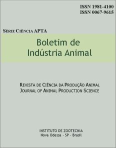Forage plants competition in São Paulo State, Brazíl. III Colina
Abstract
A field plot experiment was carried out at the Estação Experimental de Zootecnia, in Colina, State of São Paulo, Brazil. It was studied the adaptation of six grasses, fertilized and not fertilized: Panicum maximum Jacq. colomão, Panicum maximum var. trichoglume cv. Petrie - green panic, Panicum maximum Jacq. cv. Gatton panic, Setaria anceps Stapf. ex Massey cv. Kazungula, Brachiaria decumbens Stapf. Prain cv. Australiana and Hyparrhenia rufa (Ness) Stapf - jaragua and six legumes: Macroptíllium atropurpureum D C cv. Siratro, Centrosema pubescens Benth - centro, Neonotonia wightii Arnott (Lackey) cv. Tinaroo, Galactia striata (Jacq.) Urb - galáxia, Calopogonium mucunoides Desv. - calopogonio e Pueraria phaseoloides (Roxb.) Benth - cudzu-tropical. It were applied: 750 kg of limestone, 250 kg single superphosphate and 390 kg potassium cloride, in all fertilized plots and more 150 kg per hectare nitrocalcium only in grasses fertilized plots. The results showed that colonião and cudzu-tropical gave the highest dry matter and crude protein production. Colonião and centrosema were the grass and the legume with the highest crude protein content.Downloads
Downloads
Published
Issue
Section
License
Os autores não serão remunerados pela publicação de trabalhos, pois devem abrir mão de seus direitos autorais em favor deste periódico. Por outro lado, os autores ficam autorizados a publicar seus artigos, simultaneamente, em repositórios da instituição de sua origem, desde que citada a fonte da publicação original seja Boletim de Indústria Animal. A revista se reserva o direito de efetuar, nos originais, alterações de ordem normativa, ortográfica e gramatical, com vistas a manter o padrão culto da língua e a credibilidade do veículo. Respeitará, no entanto, o estilo de escrever dos autores. Alterações, correções ou sugestões de ordem conceitual serão encaminhadas aos autores, quando necessário. Nesses casos, os artigos, depois de adequados, deverão ser submetidos a nova apreciação. As opiniões emitidas pelos autores dos artigos são de sua exclusiva responsabilidade. Todo o conteúdo deste periódico, exceto onde está identificado, está licenciado sob a Licença Creative Commons Attribution (CC-BY-NC). A condição BY implica que os licenciados podem copiar, distribuir, exibir e executar a obra e fazer trabalhos derivados com base em que só se dão o autor ou licenciante os créditos na forma especificada por estes. A cláusula NC significa que os licenciados podem copiar, distribuir, exibir e executar a obra e fazer trabalhos derivados com base apenas para fins não comerciais.













